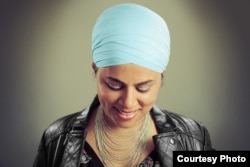In the photographs, they wear leather jackets, or superhero costumes, and hold their trumpets and helmets. They appear to be what they are: poets, musicians, bikers, soldiers — and all Sikh Americans
The Sikh Project is a collection of photographs of turbaned Sikh Americans that was on display in New York City last week. It showed their interests are as diverse as their American community.
"At its core the project is about identity in general … and how identity never restricts you," said Naroop Singh, half of the U.K. photography duo Amit and Naroop that took the photos.
"Because Sikhs, whether they're from the U.S. or the U.K., are thought of as a certain type of person — either they're doctors, engineers, accountants. ... But if you told somebody you could have a Sikh guy who's tattooed and a kickboxer, they might not believe you," Singh said.
Amit, 31, and Naroop, 35, have been working together for years, but began photographing members of their community in 2013.
In London, the photographers set out to photograph Sikhs with the goal of breaking stereotypes and showing "how cool" a Singh (male Sikh) can look. This look includes the turban, which Sikhs wear as a symbol of self-respect, courage and piety, and to show their love for and obedience to the wishes of the faith's founders.
Few step forward
At first, Amit and Naroop were hard-pressed to find sardars, or turbaned Sikh men, who would sit for them.
"They said, 'Who would ever want to see photos of Singhs?' They said, 'Don't waste your time, boys,' " Amit said. "We had to grab my grandad and say, 'Dude, look, sit here. We're gonna take a photo of you and show people how cool a Singh can look.' "
The trend caught on. When Amit and Naroop started a Kickstarter campaign to fund their first exhibition, the impact was global.
"They put one of their first images online. I saw that and was blown away by their talent and their ability to see people in a different way," said Sapreet Kaur, executive director of the Sikh Coalition, a Sikh advocacy and community development organization in New York that works to promote civil rights for all people.
Though Amit and Naroop were born and raised in the U.K., Sapreet knew they were the perfect choice to tell the story of the American Sikh. And the photographers found just as much diversity and character.
For the American project, women and children were also photographed expanding on the original idea. Though relatively few women of the Sikh faith wear a turban, or dastaar, it was important to the Sikh Coalition that those women be represented.
Amrita Khurana was one of the subjects they chose. She is the first and only sardani (turbaned Sikh woman) working for The New York Times. Amrita did not always wear a dastaar and struggled for years balancing her love for her religion with her love of hip-hop and clubbing.
Search for identity
"I was trying to find myself; I couldn't figure out who I really was," she said. "I came from a Sikh family, but my friends lived in the ghetto, and that's where I felt comfortable. I was into hip-hop and rap; that was my scene. The Sikh background was only on Sundays."
Though Amrita never lost her love for hip-hop, her devotion to her religion became stronger as she aged. And along with the worship came a fascination for Sikh identity — namely, the turban.
Amrita started wearing a dastaar only occasionally on the weekends, to temple. "One foot was in the club scene, one foot was in the dastaar scene," she said about that period in her life.
Reactions within the Sikh community to women wearing the dastaar are often mixed. While some see it as the ultimate sign of devotion, some, including Amrita's mother, believe that it should be worn only by men.
"My mom has a fit," Amrita said. "She's like, 'What are you doing? This is not OK. This is not the norm. Nobody's going to want to marry you!' "
It took years, more fights with her mother, the guidance of her priest and discussions with her husband before Amrita committed to the dastaar full time. Unlike some Sikh men and teenagers, who often have the opposite fight with their parents, wanting to cut their hair to avoid questions and stares, Amrita struggled to break gender norms within her faith community.
The look of the dastaar was almost as important to her as what it meant religiously.
"I wanted to stand out," she said. And as a turbaned woman who still sports her leather jacket on weekends, she absolutely does.
"I remember saying to her, 'Should we try it without the leather jacket?' And she said, 'No,' " Naroop said with a laugh.
Living and working in New York, Amrita said she has faced few questions and next to no hostility about her look or her religion.
From genie to terrorist
Amit and Naroop noticed a difference in how Sikhs are treated and perceived in the U.S. versus in the U.K.
"One subject here told me, 'Before 9/11, I used to walk down the road and someone would say, "Hey, look, there's a genie," ' and after 9/11 they said, 'Hey, look, there's a terrorist.' THAT's what people are going through," Naroop said.
"And the horrible thing is that in the U.S., I find that people take it, accept it as a norm," he said. "Like, I'm going to go out today and probably be verbally abused, and I'm not going to say anything back."
While Amit and Naroop were shocked, Sikh Americans share this perception and have become numb to it in the past 15 years.
Sikhs, who are often confused with Muslims in the U.S., have been the targets of violence and hate crimes, particularly after the attacks on September 11, 2001.
In 2015, a year marked by the most divisive and hateful rhetoric during a presidential campaign in decades, 174 incidents of violence against Muslims and those perceived as Muslims were reported, according to a study by Georgetown's Bridge Initiative, a multi-year research project focusing on Islamophobia.
For Sapreet of the Sikh Coalition, the goal of the exhibition was "to spark that national conversation on behalf of all communities who are lesser known and misunderstood about what it means to be an American."
Though the exhibition in Soho has closed, Amit and Naroop are working to compile a book of images from both the U.K. and the U.S. projects.












